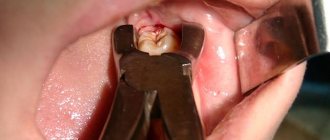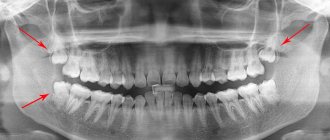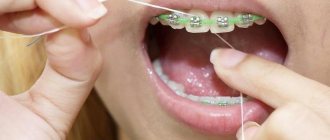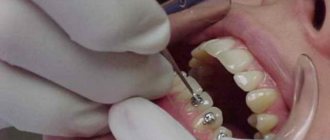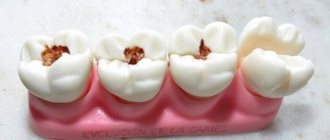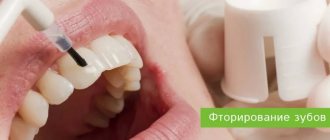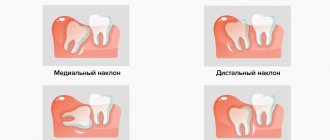An orthopedic doctor, surgeon, implantologist at the Nord Dental clinic, Alexander Nikolaevich Repin, says:
At the direction of my colleague, orthodontist Irina Konstantinovna Shevchenko, a girl planning orthodontic treatment approached me.
To get a high-quality treatment result, Irina Konstantinovna recommended that the patient remove the rudiments of wisdom teeth.
This operation is not indicated for everyone and not always. We save teeth if they do not interfere with orthodontic treatment, do not have carious lesions and do not support inflammatory processes in the oral cavity.
But there are many situations when wisdom teeth have to be removed.
For example , if the tooth is incorrectly positioned in the bone (lies horizontally, tilted towards the adjacent tooth) or for some reason cannot fully erupt.
Read about whether people today need “eighth” teeth in the article Should I remove or leave wisdom teeth?
If you need to delete...
So, if wisdom teeth still need to be removed, then the first thing the doctor needs to do is visualize the surgical field, because the better the surgeon sees, the faster and more accurately the operation will take place.
A delicate incision of the correct shape allows you to remove the tooth as carefully as possible, and then suture the wound with minimal trauma to the soft tissues.
Once it has become clearly visible , you can begin to carefully extract the tooth germs and be sure that neighboring teeth and other important anatomical formations will not be damaged.
In order for bone tissue and gums to heal quickly, in 100% of my practice I perform atraumatic tooth extraction.
Postoperative period
For complete healing of the mucosa after resection of wisdom teeth, it takes from 7 to 30 days. Recovery time depends on the complexity of the operation and the size of the existing wounds. To make this process as smooth and painless as possible, it is recommended to follow a number of rules:
- exclude traumatic factors - do not brush your teeth or rinse your mouth on the first day after the procedure
- For 7 days, when brushing your teeth, avoid direct contact with the wound;
- use only a soft toothbrush for hygiene;
- give up solid, spicy, hot and salty foods for 7-10 days;
- exclude physical activity - sports, bending, lifting weights;
- For the first time, limit taking hot baths, visiting baths, saunas - 3-4 days.
A few days after removal, the patient needs to see the attending physician.
At your follow-up appointment, the dentist will check how the gum surface is healing and rule out inflammation and possible complications. Pakhomova Anna Viktorovna Candidate of Medical Sciences, dental surgeon, periodontist, implantologist
What is atraumatic removal?
The realization that tooth extraction should only be carried out using an atraumatic method came to me when I started doing implantation.
It is this delicate approach that creates the most favorable conditions for successful implantation, since it preserves the hard and soft tissues around the tooth being removed as much as possible.
Unlike the traditional method of extraction , when the tooth is grabbed with forceps and loosened from side to side, atraumatic removal involves dividing the tooth into small pieces, from which the soft tissue is first carefully peeled off and only then parts of the tooth are removed from the socket.
Atraumatic tooth extraction is the most modern and gentle approach.
This is what the hole looks like after tooth extraction.
After the extraction, divided into pieces of the tooth, the wound is carefully sutured (the tissues are aligned along the cut line).
For suturing the wound, I use only synthetic monofilaments. Such material does not support inflammatory processes, since tissues “do not see” it and microbes cannot colonize on them.
The features of this highly effective technique used in the Bionic Dentis clinic are:
- The use of high-quality anesthesia, which completely eliminates any unpleasant and painful sensations during the procedure. If desired, all manipulations are performed in a dream.
- Removal of the wisdom tooth germ is performed using the PIEZOSURGERY ultrasonic system rather than forceps. Thanks to this, it is possible to avoid injury. If necessary, using an ultrasonic attachment, the tooth is separated from the bone tissue or divided into parts. This eliminates damage to adjacent tissues, nerves and blood vessels, as well as bone burns that occur when sawing bone with a drill.
- Sterilization of the tooth socket with a laser after extraction to prevent the formation of bacteria and infection.
- Injection of a synthetic bone preparation into the tooth socket for rapid restoration of damaged tissue. Clinic specialists use synthetic bone based on tri-calcium phosphate. This material, when compared with artificial bone of animal origin (from pigs or cattle), does not contain proteins that often cause rejection and the development of allergic reactions.
- Use of active PRF regeneration proteins obtained from the patient's blood. To do this, blood is first taken from a vein, which is processed using modern equipment installed in the clinic. You can get a blood regeneration protein drug that ensures 99% of synthetic bone engraftment in just 15 minutes.
- Place sutures at the extraction site to protect the socket from food and external irritants. This approach promotes rapid tissue healing, preventing the formation of swelling and the development of pain. This technique has no contraindications. It has been widely used for a long time in the USA and European countries, having proven itself only from the best side.
What is important for a patient to know after tooth extraction?
After the operation, I always explain to the patient “what to do,” and you can always see a reminder on the clinic’s website.
However, practice shows that patients forget that on the side where the intervention was performed, it is advisable not to chew for a week, and you should not rinse your mouth with any means, including after brushing your teeth.
For proper healing, the surgical area needs rest to preserve the blood clot.
As for situations that, in the patient’s opinion, seem abnormal or suspicious, I recommend immediately contacting the clinic.
PS.
If you are about to have teeth removed , are planning implantation or prosthetics, I am ready to advise you. Even if you are being treated at another clinic, come for a consultation to get a second opinion.
You can make an appointment on the website >>
Progress of the operation
The need to remove wisdom teeth or their rudiments is determined by a specialist during diagnostics in order to identify the causes of malocclusion, or the patient’s complaints of pain in the area where the eighth molars are located in the lower jaw. The location of the “wise men” can be seen with maximum accuracy on an x-ray.
Taking into account the patient’s age, indications and characteristics of the entire dentition/jaw, the dental surgeon determines the method of tooth extraction.
Standard operation:
- performing anesthesia (local anesthesia or general anesthesia);
- opening the gums by making an incision and peeling off the tissue;
- extraction of the germ or formed tooth from tissues;
- treating the entire surgical area with an antiseptic;
- suturing of the gums (if indicated);
- applying a bandage.
The duration of the operation can be significant. On average, removing a figure eight takes about 40 minutes. If the child is not psychologically ready for such a complex and lengthy procedure, the use of general anesthesia cannot be ruled out.
Price list for treatment
| Name of service | Price |
| Removal of a moving tooth (part of a tooth) | 2200 ₽ |
| Removal is simple | 3500 ₽ |
| Complex removal Complex tooth extraction may require additional surgical operations: excision of the hood, cutting along the bifurcation, curettage of the socket, suturing. | 4500 ₽ |
| Removal of the “eight” (“wisdom tooth”) | 6000 ₽ |
| Removal of an impacted, dystopic tooth The main reasons when removal is advisable: the tooth cannot erupt or erupts in the wrong direction. Find out what are good reasons to remove teeth? | from 9000 ₽ |
| Opening an abscess A tooth abscess is an acute inflammatory process that requires prompt medical attention, since the presence of a purulent source of infection in the oral cavity is dangerous to health. After opening the abscess, drainage and treatment with antiseptic agents are carried out. | 2400 ₽ |
| Plastic surgery of the frenulum of the upper / lower lip Irregular shape and place of attachment of the frenulum of the tongue and lips, their insufficient length and elasticity can complicate breastfeeding of the child, cause the formation of malocclusion, poor oral hygiene, periodontal problems and impaired diction. | 4350 ₽ |
| Plastic surgery of the upper/lower lip frenulum using a Doctor Smile laser Using a Doctor Smile diode laser instead of a traditional scalpel makes the operation as comfortable as possible for the patient. Find out why frenuloplasty is needed and how to do this operation painlessly | 5300 ₽ |
| Name of service | Price |
| Operation to install a Dentium implant Sometimes it is enough to make a high-quality product inexpensively and it will become in demand and popular. Thanks to companies like Dentium, modern prosthetic methods are becoming accessible and returning people's health, comfort and self-confidence. Find out more about dental implants from Dentium | 30000 ₽ |
| Ankylos implant surgery Ankylos is a reliable and clinically proven implant system that provides excellent prosthetic results with minimal risks of complications and costs less than competitors from the premium segment. Find out more about Ankylos dental implants | 35200 ₽ |
| Nobel CC Implant Surgery Dental implant manufacturer Nobel Biocare helps dentists provide the highest quality treatment for the most patients. This is based on 60 years of experience, starting with the revolutionary work of the Swedish professor Brånemark, who is rightfully considered the founder of modern implantology. Find out more about dental implants from the legendary company Nobel Biocare | 46000 ₽ |
| Sinus lifting The essence of the operation is to lift the bottom of the mucous membrane of the maxillary sinus and fill the resulting space with bone replacement material, which over time forms new bone sufficient in height, volume and quality for reliable fixation of implants. What awaits me if I need a sinus lift? | from 30500 ₽ |
| Bone grafting (in the area of the 1st tooth) Among the contraindications to the installation of implants, the most common is insufficient quantity and quality of bone tissue. Learn more about bone restoration | from 8800 ₽ |
| Name of service | Price |
| Solid metal crown Crowns are made from cobalt-chrome, nickel-chrome and titanium alloys. They are durable and good for restoring the chewing function of teeth, but do not restore aesthetics. Find out which crowns are not only durable, but also aesthetic | 10000 ₽ |
| Metal-ceramic crown Crowns consist of a cast metal base and a ceramic layer applied to the metal. Metal-ceramic crowns combine the strength of metal and the aesthetics of ceramics. Learn about the pros and cons of metal-ceramic restorations | from 16500 ₽ |
| Metal-ceramic crown on an implant | from 42000 ₽ |
| Zirconium dioxide crown Ceramic-veneered zirconium dioxide crowns are both durable and beautiful. Modern materials and technologies for the production of dental crowns make it possible to abandon the choice between “Reliability” and “Beauty”. Find out what it means to choose a crown without compromise | 38500 ₽ |
| Veneer Installing veneers on your front teeth is a sure way to a flawless smile. Veneers remove the space between teeth, change the color of darkened teeth, correct the position and shape of teeth, and cover fillings and chips. If you only agree to impeccable aesthetics in the “smile zone,” choose ceramic veneers. | 27500 ₽ |
| Permanent fixation of the crown | 1000 ₽ |
| Taking an impression | 1600 ₽ |
| Temporary crown The Dental Association of Russia (STAR) recommends the use of temporary dentures as a cosmetic and functional guideline for the manufacture of permanent denture structures. What else do you need to know about temporary crowns? | 2100 — 6500 ₽ |
| Stump tab | 7000 — 8000 ₽ |
| Removable acrylic prosthesis IVOCAP | 25000 ₽ |
| Clasp prosthesis | from 48000 ₽ |
| Flexible removable denture Acry Free Whatever opportunities modern dental implantation provides, there are patients who, for various reasons, cannot take advantage of this prosthetic technology. The Acryfree® material developed by the Israeli company Perflex makes it possible to produce aesthetic removable dentures that are completely biocompatible and do not contain components that cause allergic reactions. | from 42000 ₽ |
Indications for removing figure eights at the rudimentary stage:
- lack of space for teething - anatomical features, small jaw;
- orthodontic treatment – strengthening results, preventing relapses;
- crowding - deviation, displaced position of dental units;
- pathologies - the presence of impacted and supernumerary molars;
- surgical reconstruction of the facial skeleton;
- inflammation, injury to mucous tissue.
When treating crowding, the buds are removed to make room for the already grown teeth to move. This procedure makes bite correction more effective, reduces the duration of therapy and the risk of re-curvature.
The Importance of Removing Impacted Teeth
In an abnormal position, wisdom teeth grow in the wrong direction, disrupting the bite and development of neighboring units. Such molars make themselves felt long before they erupt, leading to crowding, aching pain and discomfort in the area of the front teeth. Without dental intervention and resection, impacted molars will constantly injure the soft tissues of the mouth and healthy neighboring units, resting on them and displacing the entire dentition. All this will ultimately lead to serious aesthetic problems in the future, which will require a lot of time and effort to correct.
Why are braces needed?
Braces are an orthodontic structure that consists of a metal arch and small plates with locks. The orthodontist attaches braces to the teeth and connects them together with metal wire with shape memory. Trying to take the correct position, the wire pulls on the braces and thus corrects the position of the teeth in the jaw.
Mostly, braces are placed on patients with malocclusion over 14 years of age. Today, bite correction is performed even on adults. If eights have already erupted, the question often arises: is it worth removing wisdom teeth before installing braces? The answer will be individual for each patient, and the doctor will be able to give it only after a preliminary examination.
Other areas related to surgery
Surgical dentistry is closely related to other dental branches, without which it is practically powerless. Therapy, orthodontics, orthopedics, and pediatric dentistry create an information and practical basis for successful treatment and surgery.
It is also worth noting that any dental discipline is interconnected and intertwined with other medical areas:
- Therapy;
- Surgery;
- Ophthalmology;
- Radiology;
- Otolaryngology;
- and others.
Also, surgical dentistry is based on data from anatomy, diagnostics, physics and physiology, because the body is an integral and interconnected system.
Do you need anesthesia?
Removing teeth for a child under anesthesia allows you to ensure calm behavior of the baby, painlessness and minimal trauma of the procedure. We do everything to eliminate situations where dental treatment becomes a psychological trauma for a child. To do this, we use modern methods of relaxation and pain relief, the choice of which is carried out in accordance with the age of the child, his psycho-emotional state, and reaction to anesthetics.
The consultation on general anesthesia is carried out by the dentist together with the anesthesiologist. It is important to understand that the presence in our clinic of a full-fledged anesthesiology and intensive care unit is what can provide parents with confidence in the safety of treating their child under anesthesia. Smaller clinics offering similar services do not have such departments, which increases the risk.
What is dangerous about malocclusion?
Violations of occlusion entail diverse consequences from gastrointestinal disorders to psychological complexes. If you are already thinking about correcting your bite, you are most likely familiar with its consequences firsthand. It is also worth noting that malocclusion often provokes premature tooth decay, as it is often the cause of pathological abrasion of teeth, the development of caries and periodontitis. In addition, the pathology can lead to overload of the temporomandibular joint, when the patient replaces clicks and crunches when opening and closing the mouth.
Problems
According to statistics, four out of five people experience complications during the eruption of wisdom teeth. They can be very diverse:
- Anomalies in size and shape that make their removal an unpredictable process.
- Undetermined number of roots.
- Dystopia is the appearance of a tooth outside the dental arch.
- Significant deviation from the vertical axis.
- Displacement of the remaining teeth, causing crowding in the anterior region and malocclusion.
- Neoplastic processes associated with the preservation of the follicle membrane.
- Inflammatory processes as a consequence of difficult eruption:
- pericoronitis (pericoronitis) - inflammation of the mucous membrane covering the chewing surface of the figure eight with the so-called hood;
- periostitis - inflammation of the periosteum (in everyday life called “flux”);
- osteomyelitis - purulent inflammation in the bone;
- abscess - an abscess in soft tissues;
- phlegmon is a diffuse purulent inflammation of soft tissues.
Often wisdom teeth are not sufficiently mineralized and are therefore susceptible to caries.
Wisdom teeth: history of the issue and causes of troubles
“Eights” are called wisdom teeth because they appear approximately simultaneously with the beginnings of experience and worldly wisdom - namely, at approximately the age of 16-25 years. And like wisdom, they bring with them many sorrows.
Wisdom teeth are in fact an atavism. We needed them during that period of historical development of mankind, when we ate much harsher food, which was not always heat-treated. Today, our delicate jaws, whose proportions have radically decreased compared to prehistoric ones, are often unable to accommodate an “extra” tooth.
Wisdom teeth begin to grow after the jaws have already formed and the dentition is already fully completed. This is the source of many non-trivial situations, various growth options, which never cease to amaze dentists and maxillofacial surgeons.
Dystopic tooth: how to remove it?
Removing a dystopic tooth is a complex surgical operation that can last up to two hours. Since the tooth is located atypically, it is difficult to “get close” to it with surgical instruments, so its extraction takes a little longer than the removal of a normally located tooth.
Before surgery, anesthesia is mandatory. First, the gums are treated with a special gel, which will “freeze” the injection site of the needle with an anesthetic drug. The injection of an anesthetic turns off the conduction of nerve impulses in the area where the dystopic tooth is located, and its removal is completely painless.
The doctor acts on a fully erupted dystopic tooth with traditional surgical instruments and gradually achieves its exit from the dental alveolus. After the tooth is removed, the tooth socket is filled with a medicine that helps accelerate the regeneration of periodontal tissues. The last stage of the surgical operation is suturing the postoperative wound.
When removing a dystopic tooth that is partially or completely under a layer of bone or epithelial tissue, the dentist will need to gain access to it for successful extraction. If the tooth “lies” in the gum, the dentist will make an incision on it, through which the dental unit will be extracted. When a dystopic tooth is located in the underlying anatomical structures, in addition to gum detachment, it will be necessary to act on the bone of the alveolar process of the jaw. Using specialized dental burs, a hole is formed in the bone through which the doctor gains access to the atypically located tooth.
If the tooth is large, its crown and roots are fragmented and removed from the bone piece by piece. Upon completion of tooth extraction, dental material is placed into the resulting hole to promote rapid bone restoration. Next, the gum tissue, like the mucoperiosteal flap, is “sutured” into place.

